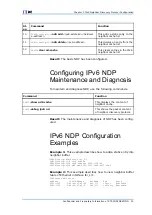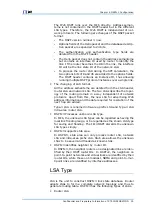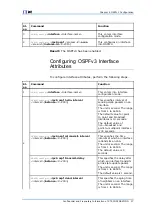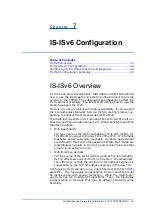
Chapter 6 OSPFv3 Configuration
The IPv6 OSPF runs over the IPv6 directly. Address seman-
teme is not contained in the OSPF header but in the different
LSA types. Therefore, the IPv6 OSPF is independent of net-
work protocols. The following are changes of the OSPF packet
format:
�
The OSPF version number 3 now.
�
Options fields of the Hello packet and the database descrip-
tion packet are expanded to 24 bits.
�
The authentication and authentication type fields are
deleted from the OSPF header.
�
The Hello packet does not contain the address semanteme
but contains an interface ID used by router to identify the
link. If the router becomes the DR in the link, the interface
ID will be the link state ID of the network LSA.
�
To process the router LSA during the SPF calculation, the
two options bits of R and V6 are added to the options fields.
The OSPF header contains an Instance ID, thus allowing
running multiple OSPF protocol instances over a single link.
�
The changing of LAS format.
All the address semanteme are deleted from the LSA header,
router LSA and network LSA. The two LSAs describe the topol-
ogy of the routing domain in a way independent of network
protocols. Apart from this, the new LSA for advertising IPv6
address information and the data required for resolution of the
next hop are added.
Type-3 LSA is renamed intra-area prefix LSA and Type-4 LSA
intra-area router LSA.
�
OSPFv3 Processes unknown LSA type.
In IPv6, the unknown LSA types can be regarded as having the
local link flooding range, or be regarded as the known LSA type
for saving and flooding. The IPv4 OSPF discards the unknown
LSA types simply.
�
OSPFv3 supports stub area
In OSPFv3, stub area can only process router LSA, network
LSA and intra-area prefix LSA. Stub area allows the unknown
LSAs to be saved and flooded as known LSAs.
�
OSPFv3 identifies neighbor by router ID.
In OSPFv3, the neighbor routers on a designated link are iden-
tified by their OSPF router IDs. In OSPFv2, the neighbors on
point-to-point networks and virtual links are identified by their
router IDs, while those on broadcast, NBMA and point-to-mul-
tipoint links are identified by interface addresses.
LSA Type
LSA is the unit to construct OSPFv3 link state database. Router
adopts LSAs to form a complete network topology and thus to
generate routing table. OSPFv3 has the following types of LSAs.
�
Router LSA
Confidential and Proprietary Information of ZTE CORPORATION
35
Summary of Contents for ZXR10 T1200
Page 5: ...Figures 71 Tables 73 List of Glossary 75 ...
Page 6: ......
















































